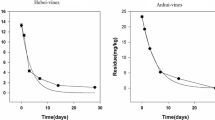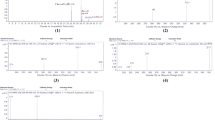Abstract
Since no attempt has been made so far in India to determine isopropyl N-(3-chlorophenyl) carbamate (CIPC) residues in potatoes, it became necessary to determine its residues in potatoes which are being used for table and processing purposes. Using high-performance liquid chromatography, CIPC residues were determined in peels, peeled tubers and unpeeled tubers periodically during storage at 10–12 °C in commercial cold stores. The highest concentration of CIPC found in potato peels was 20.17 mg/kg fresh wt, whereas in unpeeled and peeled tubers the residue levels were very low ranging from 0.29 to 1.13 and 0.05 to 0.24 mg/kg, respectively. However, all residue levels observed were within the maximum residue level prescribed by the US Environmental Protection Agency. The experiments done to determine the dispersal and concentration of CIPC applied as an aerosol fog with respect to location and time showed that the distribution of CIPC within the cold store was uneven leading to large variations in residue levels in samples drawn from different parts of the store.






Similar content being viewed by others
References
Anonymous (2002) CIPC suppliers prepared for residue limit. Potato Review (November):20–23
Boyd IMG, Dalziel J, Duncan HJ (1982) Studies on potato sprout suppressants. 5. The effect of chlorpropham contamination on the performance of seed potatoes. Potato Res 25:51–57
Camire ME, Bushway RJ, Zhao J, Perkins B, Paradis LR (1995) Fate of thiobendazole and chlorpropham residues in extruded potato peels. J Agric Food Chem 43:495–497
Conte E, Imbroglini G, Bertolini P, Camoni I (1995) Presence of sprout inhibitor residues in potatoes in relation to application techniques. J Agric Food Chem 43:2985–2987
Corsini D, Stalknecht G, Sparks W (1979) Changes in chlorpropham residues in stored potatoes. Am Potato J 56:43–50
Coxon DT, Filmer AAE (1985) The fate and distribution of chlorpropham when applied to stored potatoes as a sprout suppressant. Pestic Sci 16:355–363
Environmental Protection Agency (EPA) (1996) Registration eligibility decision. EPA-738-R-96-023
FAO/WHO, Codex Alimentarius Commission (2003) Draft and proposed draft maximum residue limits in foods and feeds at steps 7 and 4. CCPR, Rotterdam, Part 1-230
Gomez KA, Gomez AA (1984) Statistical procedures for agricultural research. John Wiley and Sons, New York
Kleinkopf GE, Brandt TL, Frazier MJ, Moller G (1997) CIPC residues on stored Russet Burbank potatoes: 1. Maximum label application. Am Potato J 74:107–117
Lentza-Rizos C, Balokas A (2001) Residue levels of chlorpropham in individual tubers and composite samples of postharvest-treated potatoes. J Agric Food Chem 49:710–714
Marth PC, Shultz ES (1952) A new sprout inhibitor for potato tubers. Am Potato J 29:268–272
Mondy NI, Sharada D, Munshi CB, Wurm CM (1992) Effect of storage time, temperature and cooking on isopropyl N-(3-chlorophenyl) carbamate levels in potatoes. J Agric Food Chem 40:197–199
Singh B, Kaul HN (1999) Analysis of chlorpropham (CIPC) residues in stored potato tubers by gas chromatography. Indian J Plant Physiol 4:121–124
Van Vliet WF, Sparenberg H (1970) The treatment of potato tubers with sprout inhibitors. Potato Res 13:223–227
Wessel PNF, Wustman R (1990) Sprout inhibiting effect of a propham chlorpropham (IPC.CIPC) mixture and its residue pattern in ware potatoes stored under warm conditions. Trop Agric (Trinidad) 67:262–266
Wilson AM, Bushway AA, Bushway RJ (1981) Residue analysis of Isopropyl N-(3-chlorophenyl) carbamate in fruits and vegetables using high-performance liquid chromatography. J Agric Food Chem 29:746–749
Acknowledgements
The authors are grateful to the Agricultural and Processed Food Products Export Development Authority, New Delhi, Ministry of Food Processing Industries, New Delhi and National Horticultural Board, Gurgaon for financial assistance. The technical assistance of Mr. Suresh is thankfully acknowledged. The authors thank the owners of Narang, Chatrakaran and Indore ice cold stores of Indore, Ujjain ice and US Katiyar cold stores of Ujjain and Mr. VK Singh of United Phosphorus Limited, New Delhi for their co-operation in this study.
Author information
Authors and Affiliations
Corresponding author
Rights and permissions
About this article
Cite this article
Singh, B., Ezekiel, R. Isopropyl N-(3-chlorophenyl) Carbamate (CIPC) Residues in Potatoes Stored in Commercial Cold Stores in India. Potato Res. 53, 111–120 (2010). https://doi.org/10.1007/s11540-010-9155-0
Received:
Accepted:
Published:
Issue Date:
DOI: https://doi.org/10.1007/s11540-010-9155-0




